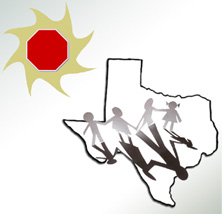TRAT2DC
Texas Risk Assessment for Type 2 Diabetes in Children

The Texas Risk Assessment for Type 2 Diabetes in Children is a state-mandated program that helps assess children who may be at high risk to develop type 2 diabetes. This assessment is conducted by certified individuals in public and private schools during vision/hearing and scoliosis screenings. Children enrolled in 1st, 3rd, 5th and 7th grades are assessed for high insulin levels. Children who are identified with the marker are also assessed for body mass index (BMI) and blood pressure. Risk assessments are issued to the parents of these children, alerting parents of the child's risk factors and encouraging further evaluation form a health professional.
The Texas Risk Assessment for Type 2 Diabetes in Children is an important program because it can help identify children who have these risk factors, all of which can increase the possibility for children to develop type 2 diabetes. Becoming aware of and understanding what the risk factors suggest can stimulate the changes necessary to prevent or delay future health problems for children who may be at risk of developing type 2 diabetes and/or other conditions.
Texas Risk Assessment for Type 2 Diabetes in Children Risk Factor Electronic System
Acanthosis Nigricans

Acanthosis nigricans (AN) is a skin marker associated with high insulin levels and insulin resistance and is considered a risk factor for type 2 diabetes and other chronic diseases. Insulin is produced by an organ called the pancreas. Insulin is important because it helps "carry" glucose to cells in the body. Glucose is the energy that cells need in order for them to function. High insulin levels indicate that the pancreas may be producing too much insulin, ant through time, can stop producing enough insulin to take glucose to the cells in the body.
Because the increasingly alarming rates of children developing type 2 diabetes, AN assessments are important and can help identify children with high insulin levels who may be at-risk for developing the disease.
Body Mass Index

Body mass index (BMI) in children is a measurement that helps determine weight status by using a mathematical formula that takes into account a child's height and weight. After the BMI is calculated, the BMI is plotted on the Centers for Disease Control and Prevention BMI-for-age growth charts.
BMI categories are identified as obesity, overweight, normal, and underweight. A child whose BMI is greater or equal to the 95th percentile on the growth charts is classified as obese. This is significant as a child who falls in this category has a greater chance of maintaining obesity throughout adulthood. Studies have also shown that BMI above the 95th percentile is associated with elevated blood pressure, high lipid levels, obesity-related disease and mortality. A child whose BMI falls between the 85th and 94th percentile is classified as overweight and should be evaluated carefully and given particular attention to secondary complications of obesity.
Blood Pressure

High blood pressure or hypertension increases the risk for cardiovascular disease and is a complication of obesity. Hypertension has also been associated with insulin resistance and hyperinsulinemia. Elevated blood pressure in childhood correlates with hypertension in early adulthood, supporting the need to track blood pressure in children.
Certified personnel perform two blood pressure measures on children who have the acanthosis nigricans marker. Blood pressure is taken on the child's right arm in a controlled environment, giving three to five minutes of rest in between each reading as recommended by the National High Blood Pressure Education Program Working Group on High Blood Pressure in Children and Adolescents. The blood pressure categories are identified as hypertensive, perhypertensive, or normal.
Information Specifically Related to the TRAT2DC Assessments
If you would like to enter your assessment information in our electronic system, please enter our RFES website by clicking on the hyperlink or on the TRAT2DC picture on the right.
If you would like further information about what Education Service Center region you are in or who your contact person is for your particular area, please consult our Regional Maps page and our Staff page.
